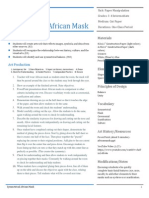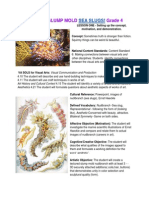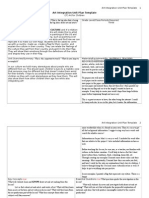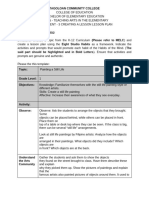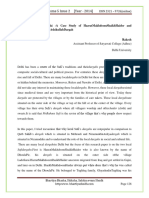Arm Lesson Plan
Arm Lesson Plan
Uploaded by
api-252035920Copyright:
Available Formats
Arm Lesson Plan
Arm Lesson Plan
Uploaded by
api-252035920Original Title
Copyright
Available Formats
Share this document
Did you find this document useful?
Is this content inappropriate?
Copyright:
Available Formats
Arm Lesson Plan
Arm Lesson Plan
Uploaded by
api-252035920Copyright:
Available Formats
Arm Cast- Body Art
Unit: African Art - Sculpture - African American Art! Lesson Plan: Arm and Face Casts - body art! Artist Of Focus: Ben Jones "
!1
Summary: Students will cast their face and/or arm for a temporary sculpture installation. They will paint it with patterns and symbols that reflect their cultural heritage. They will get input from family members for symbols to reflect ancestors. Essential Question: How is heritage reflected African Art?
"
Objectives: Students will Show awareness of characteristics of African art Cooperate with classmates to cast arm and face - demonstrate craftsmanship in plaster addition Design arm and face to show cultural heritage - reflect on personal identity Demonstrate understanding of elements and principles of design Demonstrate craftsmanship in painting
"
Materials: Plaster Gauze! Vaseline Petroleum Jelly! Plastic dishes (cool whip size)! Old t-shirts - plastic trash bags! Plastic Face Molds! (optional)! Black and white latex paint (house paint is cheaper than acrylic)! Acrylic Paint! Paint Markers! , Puffy Paint! (small squeeze bottles) - Permanent Markers! Tacky Glue! (or hot Glue Gun! )! 1" (2.5 cm) Foamboard! Scroll Saw! (optional) Vocabulary: plaster addition - pattern/repetition - concentric shapes - exaggeration distortion - geometric - culture - ritual - symbolism - identity - adornment Resources: See additional info. and student sample work of this lesson here. Variety of African mask images! - images of body art and adornment! from Africa (some good articles have been in National Geographic! ) Images of arm face casts by Ben Jones! Images of other African American artists showing inspiration from art of Africa (find some books on Contemporary African American art. I have seen some with Ben Jones work shown). Images of Ndebele painting (this is optional for painting background Dow foam board) Some tips and photos for mask making
!2
" "
http://www.mendels.com/mask.html http://bayard.daysofyoreevents.com/ursula-masks.htm "Revealing the Hopes of Adolescents through the Art of Tattoos" by Michael Gerrish http://whyart.com/tattooarticle.htm
This is a face cast on foam board. Sculpture is painted with Acrylic Paint! and sealed with polymer medium. Instruction/Motivation: 1. Present some introductory activities on African Masks (see the Ceramic Mask lesson plan) - show examples of body adornment (in various African cultures - and other cultures). Discuss the concept of culture and how art reflects culture 2. Show some examples of African American art - discuss inspiration from art of Africa (especially Ben Jones). 3. Review/demonstrate casting process!
"
Procedures: 1. Students look at and discuss significance/purpose of African masks understand meaning - discuss similarities/characteristics (at least one day introduction to African art). Look at body adornment in various cultures. 2. Student look at African American Art and see connections to African art look for similarities. Also look at influence of African art on Modern Art. 3. Students research design/art in their own culture - symbols - textiles imagery. Learn about the beliefs and values of their ancestors. Learn about the flora and fauna of the homeland - the landscape. Make a mini journal of their findings - including sketches. Make a tracing of oval shape for face and an outline for arm to do some planning - this can be on going through the lesson and can change. 4. Decide if you will have students do face cast - arm cast - or both. Students will work in pairs to cast face and arm. Wear old T-shirt to do arm. Stretch arm out on table - keep it flat. Only cast the top side of the arm - all the way up to shoulder. Do not wrap around to underside of arm. Use petroleum jelly on arm. Apply at least two layers of plaster gauze. See resources above for face cast. 5. For individual works - glue and mount onto strips of Dow board. Mount face and arm vertically. Seal arm and face around edges with strips of plaster gauze. For a group work, it might be easier to paint the face and arms first, they carefully mount to the 4' x 8' (1.22 x 2.44 meters) boards and touch up. Work on drawings while plaster is drying.
!3
6.
" " "
When plaster is completely dry -paint with base coat. Keep it simple. Chose black or white for base coat. Work on designs while paint is drying. Plan designs for background board, too. These can be inspired by wall paintings of Ndebele and other wall paintings in South Africa. 7. Transfer designs to face and arm casts. Black permanent markers can be used on white surface. White paint markers on black (or use gold and/or silver Metallic Markers! ) 8. Paint patterns - designs and symbols with acrylic paint. Permanent markers work well on white surface for details. Paint markers can be used on black surface for details. Embellish with squeeze paints (middle school students love using these) - just use for pattern and line. 9. If you are doing the cut out for the face on the Dow board - students can collage materials on the inside of the face - "What's inside my head?" "What issues are important to me?" 10. Decide if entire mounting board needs to be covered with gauze. Paper mache would be much cheaper. Paint mounting board. You could leave these solid white or black for contrast - OR paint with bolder patterns/ geometric designs (See Ndebele painting). If mounting on one or more 4' x 8' Dow boards, come up with a way to hinge these together so they are displayed free standing so people can walk around them and see the back side. On the back side, there could be an outline of the arm below the cutout of the face and that could be collaged as well. The cut out of the arm could be a tracing done on poster board and glued to the display board. Arm could be collaged first - then cut out. 11. Student write a reflection on their work. What do the motifs mean? How do they express culture? What have they learned about their ancestors?
!4
! Black Face and Arm Unit by Ben Jones, 1971. Not only does he have an interesting composition, he also had added creative patterns and colorful designs to his sculptures.
!5
You might also like
- Symmetrical African MaskDocument2 pagesSymmetrical African Maskapi-263381268No ratings yet
- Week 1 Lesson 2Document17 pagesWeek 1 Lesson 2api-252776499No ratings yet
- Art and The Elementary CoreDocument83 pagesArt and The Elementary CoreSpringville Museum of Art100% (3)
- Unit Plan On ZinesDocument28 pagesUnit Plan On Zinesapi-265991000No ratings yet
- Imaniarline Lesson PlanDocument7 pagesImaniarline Lesson Planapi-219579171No ratings yet
- African Family Portrait ContoursDocument3 pagesAfrican Family Portrait Contoursapi-263804887No ratings yet
- GR 4 - Squirmy Slump Mold Sea SlugsDocument6 pagesGR 4 - Squirmy Slump Mold Sea Slugsapi-242430314No ratings yet
- Picasso FrankenstienDocument6 pagesPicasso Frankenstienapi-242481603No ratings yet
- Visual Arts Lesson PlanDocument4 pagesVisual Arts Lesson PlanCarleighNo ratings yet
- ThedotDocument3 pagesThedotapi-263381268No ratings yet
- Chinese Painting: Bamboo Brush Painting: GRADE 2 & 3 Artist: Hua Tao ZhangDocument6 pagesChinese Painting: Bamboo Brush Painting: GRADE 2 & 3 Artist: Hua Tao ZhanggeorgeNo ratings yet
- Picasso Lesson PlanDocument3 pagesPicasso Lesson Planapi-348024442No ratings yet
- Art Planner Week 6-10Document2 pagesArt Planner Week 6-10LaurencassarNo ratings yet
- Keith Haring Lesson Plan - LoriDocument6 pagesKeith Haring Lesson Plan - Loriapi-251158064No ratings yet
- Art Lesson Plan - Maasai NecklaceDocument2 pagesArt Lesson Plan - Maasai Necklaceapi-295125174No ratings yet
- Kente Cloth Lesson PlanDocument4 pagesKente Cloth Lesson Planapi-263998250No ratings yet
- Leaf SymmetryDocument3 pagesLeaf Symmetryapi-213444043No ratings yet
- XXX Junior School Art Planning Year Five Unit One Native American ArtDocument8 pagesXXX Junior School Art Planning Year Five Unit One Native American ArtHaroon4j201No ratings yet
- Watercolor UnitDocument21 pagesWatercolor Unitapi-307469132No ratings yet
- ArtlessonplanportfolioDocument3 pagesArtlessonplanportfolioapi-271342206No ratings yet
- Sequenced Lessons For Creative ArtsDocument8 pagesSequenced Lessons For Creative Artsapi-299208589No ratings yet
- MaasaicolorwheelDocument2 pagesMaasaicolorwheelapi-263381268No ratings yet
- Aboriginal Art: Angeline Eskelsen ART 3700 Lesson Plan 3-IntegratedDocument3 pagesAboriginal Art: Angeline Eskelsen ART 3700 Lesson Plan 3-IntegratedAngeline EskelsenNo ratings yet
- Visual ArtsDocument4 pagesVisual Artsapi-203830227No ratings yet
- Art Integration Unit Plan TemplateDocument10 pagesArt Integration Unit Plan Templateapi-281815279No ratings yet
- Art - Fashion Design Concepts and LessonDocument18 pagesArt - Fashion Design Concepts and LessonRalucaFlorentina100% (2)
- Visual Arts t2Document11 pagesVisual Arts t2api-243600639No ratings yet
- Paper QuiltsDocument3 pagesPaper Quiltsapi-7383252270% (1)
- Twig Journal Lesson PlanDocument5 pagesTwig Journal Lesson Planapi-490399337No ratings yet
- Kindergarten Lesson PlanDocument12 pagesKindergarten Lesson Planapi-458769667No ratings yet
- Group 5 Lesson PlanDocument8 pagesGroup 5 Lesson Planapi-284871208No ratings yet
- Art Lesson Plan: Instructional Objectives (2-3)Document2 pagesArt Lesson Plan: Instructional Objectives (2-3)api-263886939No ratings yet
- Simple To Follow Guide To Art Projects For Both Primary and Secondary StudentsDocument38 pagesSimple To Follow Guide To Art Projects For Both Primary and Secondary Studentskimi wa hitori najaNo ratings yet
- Kirk Maynard Art Class Unit PlanDocument5 pagesKirk Maynard Art Class Unit Planapi-242706637No ratings yet
- Lesson Plan For ARTS: OutcomeDocument5 pagesLesson Plan For ARTS: OutcomeMrs. Farhat BilalNo ratings yet
- Lesson Plan - ArtDocument3 pagesLesson Plan - ArtZee NaNo ratings yet
- Art Lesson Plan-Symmetrical African MaskDocument2 pagesArt Lesson Plan-Symmetrical African Maskapi-263804887No ratings yet
- Naturalistic LearningDocument6 pagesNaturalistic Learningxinwei831No ratings yet
- Maydel Joy Dalap - Assignment 3 - Creating a Lesson Plan in ArtsDocument2 pagesMaydel Joy Dalap - Assignment 3 - Creating a Lesson Plan in ArtsMaydel Joy Nepaya DalapNo ratings yet
- Jim Dine 1st Edtpa FormatDocument19 pagesJim Dine 1st Edtpa Formatapi-248529793No ratings yet
- Layout Lesson Plan For School PaperDocument6 pagesLayout Lesson Plan For School PaperAshley BruasNo ratings yet
- Seton Hill University Daily Lesson Plan For Student TeachersDocument4 pagesSeton Hill University Daily Lesson Plan For Student Teachersapi-200889489No ratings yet
- Ela:art-Gr 2Document3 pagesEla:art-Gr 2api-265671170No ratings yet
- CD Cover Lesson PlanDocument2 pagesCD Cover Lesson Planspektorish100% (1)
- Zine (Cartoon) Unit Plan RevisedDocument20 pagesZine (Cartoon) Unit Plan Revisedapi-264279988No ratings yet
- 2 Study Guide s1q1 2 2014Document6 pages2 Study Guide s1q1 2 2014api-417344113No ratings yet
- Native American Kachina Dolls Lesson Plan 8th GradeDocument3 pagesNative American Kachina Dolls Lesson Plan 8th Gradeapi-235914495100% (1)
- 3rdgrade Memoryquilts 5Document6 pages3rdgrade Memoryquilts 5api-282873721No ratings yet
- Art 10 - Wire Self-PotraitsDocument12 pagesArt 10 - Wire Self-Potraitsapi-535552931No ratings yet
- Freedom From Representational Qualities in ArtDocument3 pagesFreedom From Representational Qualities in Artapi-362249689No ratings yet
- Eleanor Mccain - A Quilt of Many ColorsDocument4 pagesEleanor Mccain - A Quilt of Many Colorsapi-214156146No ratings yet
- Edci301 Integratedartlesson KNDocument9 pagesEdci301 Integratedartlesson KNapi-253458327No ratings yet
- Andy Warhol Art Crayon PopArt LessonDocument11 pagesAndy Warhol Art Crayon PopArt LessonDammmmmmm100% (3)
- Impressionist Drawing g-45Document2 pagesImpressionist Drawing g-45api-242644894No ratings yet
- ART Grade 1 Teaching GuideDocument3 pagesART Grade 1 Teaching GuideLary BagsNo ratings yet
- Tessellations Using TranslationDocument5 pagesTessellations Using Translationapi-214156146No ratings yet
- Lesson 2Document6 pagesLesson 2api-253523338No ratings yet
- Scolelesson Grade2Document4 pagesScolelesson Grade2api-337282367No ratings yet
- Learning About Art: Art Ideas for Primary School TeachersFrom EverandLearning About Art: Art Ideas for Primary School TeachersRating: 5 out of 5 stars5/5 (1)
- Murphyltr3 7 14Document1 pageMurphyltr3 7 14api-252035920No ratings yet
- Brandy Nicole Murphy Resume March 2014Document3 pagesBrandy Nicole Murphy Resume March 2014api-252035920No ratings yet
- Cityscape Drawing LessonDocument5 pagesCityscape Drawing Lessonapi-252035920No ratings yet
- Artist Statement-Fill inDocument1 pageArtist Statement-Fill inapi-252035920No ratings yet
- Chapter 1 Ece351 Digital SystemsDocument49 pagesChapter 1 Ece351 Digital SystemsAfeef Abu BakarNo ratings yet
- 00 Life Sciences Grade 10 PPT Connective TissuesDocument28 pages00 Life Sciences Grade 10 PPT Connective TissuesCleopatra NomathamsanqaNo ratings yet
- The Required Function Definitions Are As FollowsDocument3 pagesThe Required Function Definitions Are As FollowsAyushi DiwakarNo ratings yet
- 5 ENVI Geologic - Hyperspectral PDFDocument5 pages5 ENVI Geologic - Hyperspectral PDFLuiz BecerraNo ratings yet
- T40140Document61 pagesT40140Were Wolf60% (5)
- Snbs Profile 2018.Document9 pagesSnbs Profile 2018.Ravi KashyapNo ratings yet
- Organ of CortiDocument6 pagesOrgan of CortiNTA UGC-NETNo ratings yet
- Problems of Community MuseumDocument57 pagesProblems of Community MuseumIqRa JaVedNo ratings yet
- Chapter TwoDocument12 pagesChapter TwoABAYNEGETAHUN getahunNo ratings yet
- NCM - 104-CHN 1: Lesson 2Document54 pagesNCM - 104-CHN 1: Lesson 2Just PhearlNo ratings yet
- Case Study Kalve BodDocument13 pagesCase Study Kalve BodDEVA PRIYA ANIL 1861724No ratings yet
- Final Research GumamleaDocument29 pagesFinal Research GumamleaShiela Mae LiwanagNo ratings yet
- Local Dargah S in Delhi A Case Study ofDocument14 pagesLocal Dargah S in Delhi A Case Study ofMohammed Abdul Hafeez, B.Com., Hyderabad, IndiaNo ratings yet
- Lab CMC54Document6 pagesLab CMC54jhojan15No ratings yet
- Dengue Lecture For SibalomDocument48 pagesDengue Lecture For SibalomCzerwin JualesNo ratings yet
- IEEE STD ANSI-IEEE STD 1004-1987Document14 pagesIEEE STD ANSI-IEEE STD 1004-1987abdou samiNo ratings yet
- A Study On Online Payment Webapplications in India With Reference To Google PayDocument6 pagesA Study On Online Payment Webapplications in India With Reference To Google Paybexel92348No ratings yet
- Data Science: Chapter 1: Introduction To Big DataDocument77 pagesData Science: Chapter 1: Introduction To Big DataHrishikesh Dabeer100% (2)
- Crude Oil ProcessingDocument9 pagesCrude Oil ProcessingThariqNo ratings yet
- Nirma Washing PownderDocument17 pagesNirma Washing Powndergayatri_bksNo ratings yet
- How To Build A DIY Garage Storage Wall System - Building StrongDocument4 pagesHow To Build A DIY Garage Storage Wall System - Building StrongHeather RussellNo ratings yet
- Methods and Techniques of ResearchDocument69 pagesMethods and Techniques of ResearchTimothy Dalingay Jr.100% (14)
- CF 5Document42 pagesCF 5b meherbabaNo ratings yet
- Iso 6752 1984Document8 pagesIso 6752 1984Nazeeh1No ratings yet
- Anti-Aging - UniScience GroupDocument7 pagesAnti-Aging - UniScience GroupAnonymous 2gIWpUcA8RNo ratings yet
- Bagasse Drying MethodsDocument3 pagesBagasse Drying MethodsParmasamy SubramaniNo ratings yet
- CES-274 - D 36005 Construction RulesDocument7 pagesCES-274 - D 36005 Construction Rulesgurumechtarkanz_3885No ratings yet
- English Grammer STD 5Document16 pagesEnglish Grammer STD 5robertvsodaNo ratings yet
- 1cvugrjrg 825000Document156 pages1cvugrjrg 825000BrayanNo ratings yet
- Music 9016 Songs, 50.9 Days, 74.80 GBDocument44 pagesMusic 9016 Songs, 50.9 Days, 74.80 GBapi-25916367No ratings yet
